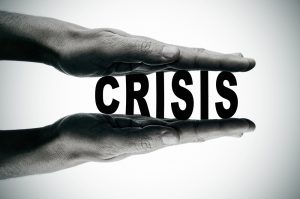Obviously crisis counseling is sometimes on the scene of the event. It is emotional first aid that attempts to restore equilibrium and mobility to the person. It is short term in its plan and it briefs the individual and carries through necessary tasks to help the person return to pre-crisis state. It also looks to help the person find orientation and resources to help avoid future crisis and find resolution to what caused the crisis reaction.

In this blog, we will look at crisis counseling in settings where intake occurs and how counselors work to help individuals leave the state of crisis. In these cases, the individual is brought in by the police, or rescue and the person requires mental care until able to be released. These types of counseling sessions differ greatly from traditional counseling settings. They still are not long term but they do look to alleviate crisis as much as any work on the scene itself. In addition to reviewing these types of crisis counseling settings, we will look at the efforts to better concert the police with mental health professionals in ensuring mutual safety of first responders and those in crisis.
Please also review AIHCP’s Crisis Intervention Specialist Program, as well as its Substance Abuse Specialist Program for qualified professionals in Human Services and first response.
Crisis Counseling in Facilities
Many mental health community centers are equipped to handle walk-ins, police escorted individuals in crisis, family admitted or social service recommended cases (James, 2017, p. 100). Like the crisis specialist in the field and on the scene, these professionals provide the same type of de-escalation model to help the person find equilibrium and mobility. They can also keep the person a few days if necessary and later coordinate with case managers to ensure the person receives continued observation, medication, or future counseling. Some facilities are 24 hour facilities, while others have emergency call centers beyond the regular hours (James, 2017, p. 102).
Upon entry into a facility, a person is assessed across the range of the triage scale to determine if someone is mildly or severely impaired. For more severe cases, a senior technician is called upon to help the person. Crisis specialists will also try to receive a case history of the person to better determine the onset of crisis. If mental pathology is present, a psychiatrist may be called to better meet the needs of the person (James, 2017, p. 100). James also references that those who face more severe mental fragmentation will be committed until safe to self and others (2017, p. 100).
The initial intake interview is a key process where questions and basic crisis intervention tasks can be completed. If the person is appraised negatively with a high level of lethality as well as drug use, then the person will need to stay longer. The clinician or team following the intake interview, prepares a disposition that describes the case as well as suggestions for treatment. In some cases, the facility will supply the person with a psychological anchor. This refers to a professional who will serve as their case worker, advocate or contact person (James, 2017, p. 101). In some cases, the individual will need short term disposition which meets the immediate physical needs of food, water or shelter. The Department of Family Services plays a big role with social workers to ensure the proper government entities meet the needs of the person. However, sometimes, long term disposition occur where the person needs long term care plan which includes counseling abd medication to help the person deal with future issues and crisis (James, 2017, p. 101).
Crisis and Short Term Vs Counseling and Long Term Cases
Since crisis is about mental and emotional first aid that looks to stop emotional bleeding, its goals and procedures to reach those goals differ greatly from long term counseling and cases. James lists numerous differences between these two types of mental health models. In regards to the initial tasks themselves, there is a large difference. Crisis counseling looks to ensure client safety and assess lethality initially, while long term looks to prevent future problems. Where crisis counselors look in the first task to form a bond with the person in crisis, long term counselors look to correct issues with sound and tested evidence based treatments. Where crisis counselors help the person define the immediate problem, long term counselors help provide systematic support for that problem. Where crisis counselors provides support to help calm the person in crisis, long term counselors help facilitate growth in the healing process. Where crisis counselors look to help those in crisis see alternate options and develop a plan, long term counselors look to re-educate and help clients express and clarify emotions. Where crisis counselors resolve with commitment to plan and follow up, long term care counselor continue treatment with resolving issues, accepting realities, reorganizing attitudes and working on maximizing intellectual resources to deal with issues (2017, p. 98).

Crisis intervention specialists utilize diagnosis via the triage method looking at the affective, behavioral and cognitive issues on the spot and face to face, while long term counselors work with a detailed case history as well as observation throughout a period of time with most patients not experiencing a state of acute crisis. Where crisis specialists treat acute trauma and help to stabilize, long term counselors look at the underlying causes for issues over an extended period of time. Where a crisis specialist’s plan is to meet the immediate physical and emotional needs to stabilize a person, a long term counselor’s plan is a comprehensive effort that covers time and numerous personal and social environments that looks to help alleviate a non acute issue. (James, 2017, p. 98). Hence crisis intervention specialists deal with individuals who are affectively in an impaired state, cognitively unable to think logically and behaviorally out of control and pose a threat to themselves and others, while a long term counselor deals with individuals not in impairment emotionally and is able to think and socially behave (James, 2017, p. 99). This means that crisis professionals whether on the scene, or in a facility helping a person in crisis are working at a mental emergency level where decisions and observations must be quicker and plans may need be adjusted quickly due to safety issues (James, 2017, p. 99)
Types of Issues with Crisis
Obviously dealing with those in crisis requires quick thinking and assessment but it also entails dealing with individuals who are a lethal threat to self and others, as well as many times on multiple types of drugs. Crisis professionals deal with chronic mental illness, acute interpersonal problems due to relationships and other social factors, and combinations of both (James, 2017, p. 97). While long term care counselors deal with these type of issues, usually the person is not actually intoxicated, or in a state of mania, or suicidal with gun in hand during a session. Many crisis counselors deal with an array of acute issues that include those who are constantly in a transcrisis state that can be activated at any moment. Those facing multiple stressors or anxiety or depression can easily fall into a state of acute crisis in these cases. In addition to transcrisis, many individuals in chronic crisis will face regression and fall back into old issues that led to crisis. Others may face issues with possible termination of future sessions with counselor since the counselor has become an anchor (James, 2017, p. 108). In addition to dealing with those in transcrisis, many counselors deal with individuals with addiction issues and psychotic breaks with reality. One common type of malady that corresponds with crisis in Borderline Personality Disorder. This disorder prevents the person from past trauma to achieve stable moods from hour to hour, day to day or month to month. They can erupt into anger or sadness over minor things they perceive as slights. Many are also impulsive, self destructive, confused with goals, unable to maintain self esteem, possess suicidal ideation, and have destructive choices in relationships (James, 2017, p. 111). Obviously this type of disorder is a chaotic recipe for crisis calls for the police and later mental health intervention.
These types of issues can lead to big problems with counselors and those in crisis as well as those who offer long term counseling. It can lead an array of issues where the client is suicidal, deals with abuse, or problems with finances or the law, as well as one who frequently misinterprets a therapist’s statements, reacts strongly to advice, fears resistance and follow through of treatments, as well as transgressing professional boundaries with calls and insults (James, 2017, p. 111). James points out that when dealing with individuals in chronic crisis or facing other mental maladies, one needs to set ground rules that apply for everyone. Sessions need to start and end on time. Sessions need to be void of threats. Everyone speaks for oneself and is fully heard. Everyone faces all issues discussed and does not have the option to abruptly leave. The session will not include gaslighting or avoiding the subject. No one is to arrive drunk or intoxicated. The crisis counselor or counselor will not take sides. Time will be respected outside the office and the needs of other clients will not be dismissed for another’s immediate demands (James, 2017, p. 114). Obviously dealing with those that face multiple issues and chronic crisis is a heavy task. It involves professionalism, boundaries and sometimes a place to vent for the counselor afterwards.
Crisis Facilities and Law Enforcement
Since the closing of mental asylums in 1963, law enforcement and prisons have picked up the slack of dealing with those in mental crisis. This has led to many unfortunate incidents of police shootings, or police brutality cases. While most police officers and law enforcement are good people, the job of dealing with those in mental crisis is exhausting and can trigger a sane individual into actions not normal for fear of safety of self or frustration. Most police historically have dealt with criminals in the true sense. Upon apprehending of a thief, the thief understands to drop the weapon or the stop. Unfortunately in heated situations of mental crisis, people sometimes cannot emotionally understand or comprehend orders. Due to equilibrium and immobility of a person in crisis, an officer has to show constraint and avoid authoritative and aggressive commands or he/she may escalate the situation. Some officers are not able to handle this type of mental health interaction but modern policing requires it. As more and more unfortunate death by cop whether intentional or intentional occurs, the more police need trained in crisis intervention and de-escalation. Police officers who cannot handle this adjustment either need to find a new profession or soon risk the chance of ending up in prison, sued, or fired themselves.

James mentioned the change in policing from instrumental crimes to more expressive crimes where officers are required to adjust their approach in dealing with the person in crisis (2017, p. 102). James illustrated one of the first joint task teams of law enforcement and mental health and crisis centers with the Memphis Police Department in 1987 (James, 2017. p. 103). The Crisis Intervention Team or CIT was designed to train police when dealing with those in crisis as well as to coordinate with mental facilities instead of prisons. James pointed out that the model was not just about training police but also to help create better coordination with the mental health community and consumer advocates promoting mental health awareness (2017, p. 104). James pointed out that the program covered 40 hours of CIT training that covered cultural awareness of mental illness, substance abuse, developmental disabilities, treatment strategies and mental health resources, patient and legal rights in crisis intervention, suicide intervention, use of mobile crisis teams, education on psychotic meditations and effects, verbal defusing and de-escalating techniques and education on borderline personality disorder and other mental issues (2017, P. 105).
According to James, the program has been a success and a model for other law enforcement agencies in other communities and cities. Within its first 16 months of operation in 1987 to 1988, Memphis CIT trained officers responded to 5, 831 mental disturbance calls, transported 3, 424 cases to proper mental health facilities without patient fatality (2017, p. 106). In the 20 and more years since, more calls are received to the hotline differentiating crime and mental crisis and there has been a reduction in the use of force and more individuals being sent to mental facilities instead of jail (James, 2017, p. 106).
This is an important issue and the success shows that modern policing can meet the needs of mental crisis. Some departments also receive additional aid from social workers, chaplains and other crisis professionals on calls related to mental disturbance. This does not mean that danger and risk exists both for the person in crisis as well as the first responders but it does reduce the chance for unnecessary and tragic fatality. This should be an issue every person cares about because anyone can become a victim of crisis and police when called need to be able to de-escalate and not escalate.
Conclusion
Crisis intervention care is not for the faint of heart. It requires quick thinking and decisions which need to be adjusted on the fly as danger and possible death loom with every call. Crisis cases whether on scene or in a facility deal with acute crisis. Individuals are facing dis equilibrium and immobility. They are affected emotionally, behaviorally and cognitively. This leads to a different type of response than long term care. Crisis counselors understand the different nature of their calling and profession. In addition, mental health facilities, the public, and police are all beginning to incorporate better crisis response to negate police brutality or illegal shootings of those in crisis. This involves understanding that modern policing is more about arresting bad guys but also helping sick people find balance and the proper treatment.

Please also review AIHCP’s Crisis Intervention Specialist Certification as well as its Substance Abuse Specialist Certification. Both programs are online and independent study with mentorship as needed. The program is open to qualified professionals in law enforcement, healthcare, mental health, human services and chaplaincy.
Source
James, R. & Gilliland, B. (2017). “Crisis intervention Strategies” (8th). Cengage
Additional Resources
Crisis Centers by State and U.S. Territory. Access here
Crisis Text Line. Access here
If You or Someone You Know is in Crisis and Needs Immediate Help. National Institute of Mental Health. Access here
National Hotline for Mental Health Crises and Suicide Prevention. NAMI. Access here
Tich, B. (2023). “What Works in De-Escalation Training”. National Institute of Justice. Access here
Zeller, S. & Kircher, E. (2020). “Understanding Crisis Services: What They Are and When to Access Them”. Psychiatric Times. Access here

















 Written by Sam Darwin
Written by Sam Darwin
 How Does IOP Differ From Traditional Outpatient Programs?
How Does IOP Differ From Traditional Outpatient Programs?
